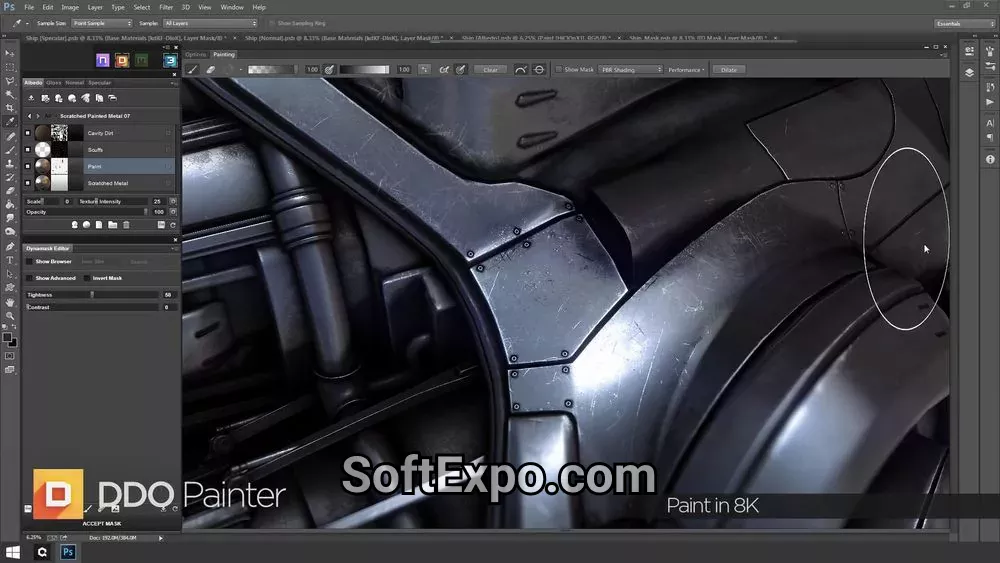All rights reserved © 2025
Quixel Suite was a Photoshop‑centric texturing toolkit that stitched together NDO, DDO, and 3DO into a single workflow for building PBR materials and previewing them on real game assets. For a long time it sat in the same mental space as Substance Painter: you brought in a UV‑unwrapped model, ran a bake, layered smart materials in DDO, added high‑frequency normal details in NDO, and verified everything in 3DO’s realtime viewport. Even though Quixel Suite 2 has now been discontinued in favor of Megascans, Bridge, and Mixer, it is still widely used in legacy pipelines and worth understanding if you inherit older projects or training material.
DDO for PBR material painting.
DDO (often branded as DDO Painter in Quixel Suite 2) handled physically based texturing inside Adobe Photoshop: you worked with albedo, roughness, metalness, normal, and ambient occlusion channels through a layer‑based UI, then pushed smart materials and masks onto meshes driven by baked maps. For many artists this was the on‑ramp from flat diffuse workflows to full PBR texturing without leaving Photoshop.
NDO for normal map authoring.
NDO was the normal‑map creation side of Quixel Suite, turning Photoshop into a sculpting and detailing surface for high‑quality normals. You could draw shapes, bevels, screws, panels, and micro‑detail as regular 2D layers and instantly see the result baked into a tangent‑space normal map, which made it a favorite for hard‑surface artists.
3DO for realtime preview and baking.
3DO was the 3D viewport and helper app: it previewed your DDO and NDO work on the actual model, with IBL lighting, HDR environments, and support for multiple materials. In Quixel Suite 2, 3DO also gained texture baking capabilities, so you could perform AO, curvature, and other supporting bakes directly in the Suite instead of bouncing to external bakers.
In short, Quixel Suite bundled a PBR material painter (DDO), a normal map painting tool (NDO), and a realtime 3D viewer and baker (3DO) into a single Quixel Suite 2.0 package that lived on top of Photoshop.

Epic Games acquired Quixel, then focused development effort on Megascans (the photogrammetry asset library), Quixel Bridge (the asset manager), and Quixel Mixer (the standalone material authoring app). As part of that transition, Quixel Suite—which comprised NDO, DDO, and 3DO—was officially discontinued, with the team steering new users toward Mixer and Megascans instead.
That means you will mostly encounter Quixel Suite in three places: older studio pipelines that still rely on Photoshop‑based texturing, archived Quixel NDO/DDO training courses, and legacy projects where re‑authoring everything in Mixer or Substance 3D Painter is not realistic. Understanding how the Suite was structured helps when you migrate assets or rewrite material workflows for modern tools.
1) Start with a clean, UV‑unwrapped mesh.
Quixel Suite expected a well‑unwrapped, triangulated mesh exported from your DCC (3ds Max, Maya, Blender, etc.), plus a consistent naming scheme for material IDs and texture sets. In older tutorials you will often see low‑poly and high‑poly variants fed into 3DO or external bakers to generate normal, AO, and curvature maps.
2) Bake maps and launch DDO.
Once you had your supporting maps, you launched DDO from Photoshop, pointed it at the mesh, the baked textures, and your target renderer or engine (Unity, Unreal Engine, custom). DDO then created a project with the appropriate PBR channels and smart materials, ready for masking and wear‑and‑tear passes driven by curvature and AO.
3) Add detail with NDO.
For panel lines, bolts, vents, and high‑frequency detail that would be too heavy to model, you opened NDO and painted directly into the normal map using Photoshop layers and brush tools. Because NDO updated the normal map in realtime, you could iterate much faster than sculpting and rebaking for every small change.
4) Iterate in 3DO’s viewport.
With materials and normals in place, 3DO let you orbit around the asset, switch HDRI setups, and tweak material parameters live to check how the asset would render in engine. In Quixel Suite 2, 3DO’s ability to handle baking and higher‑quality preview made it the central “truth” of whether a texture set was ready to ship.